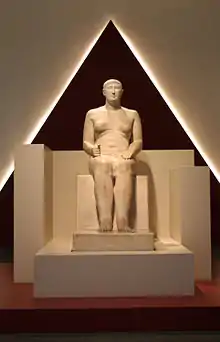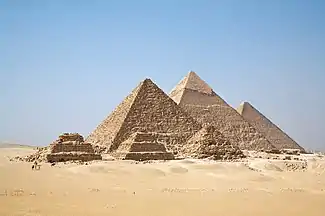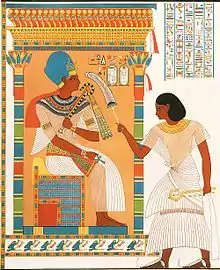Vizier (Ancient Egypt)
The vizier (/vɪˈzɪər/ or /ˈvɪzɪər/) was the highest official in ancient Egypt to serve the pharaoh (king) during the Old, Middle, and New Kingdoms.[1] Vizier is the generally accepted rendering of ancient Egyptian tjati, tjaty etc., among Egyptologists.[2] The Instruction of Rekhmire (Installation of the Vizier), a New Kingdom text, defines many of the duties of the tjaty, and lays down codes of behavior. The viziers were often appointed by the pharaoh. During the 4th Dynasty and early 5th Dynasty, viziers were exclusively drawn from the royal family; from the period around the reign of Neferirkare Kakai onwards, they were chosen according to loyalty and talent or inherited the position from their fathers.[3]

| Vizier (Tjaty) in hieroglyphs |
|---|
Responsibilities
The viziers were appointed by the pharaohs and often belonged to a pharaoh's family. The vizier's paramount duty was to supervise the running of the country, much like a prime minister. At times this included small details such as sampling the city's water supply.[4] All other lesser supervisors and officials, such as tax collectors and scribes, reported to the vizier. The judiciary was part of the civil administration, and the vizier also sat in the High Court. At any time, the pharaoh could exert his own control over any aspect of government, overriding the vizier's decisions. The vizier also supervised the security of the pharaoh and the palace by overseeing the comings and goings of palace visitors.[5] The viziers often acted as the pharaoh's seal bearer as well, and the vizier would record trade.[6] From the Fifth Dynasty onwards, viziers, who by then were the highest civilian bureaucratic official, held supreme responsibility for the administration of the palace and government, including jurisdiction, scribes, state archives, central granaries, treasury, storage of surplus products and their redistribution, and supervision of building projects such as the royal pyramid.[7]In the New Kingdom, there were two viziers, one for Upper Egypt and one for Lower Egypt.[8]
Installation of the Vizier
According to the Installation of the Vizier, a New Kingdom document describing the office of the vizier, there were certain traits and behaviors that were required to be a vizier:
- Act by the law
- Judge fairly
- Do not act willfully or headstrong
List of viziers
Early Dynastic period
| Vizier | Pharaoh | Dynasty | Comments |
|---|---|---|---|
| Menka | Ninetjer? | 2nd Dynasty | Earliest known holder of the title |
Old Kingdom
Middle Kingdom and Second Intermediate Period
| Vizier | Pharaoh | Dynasty | Comments |
|---|---|---|---|
| Bebi | Mentuhotep II | 11th Dynasty | |
| Dagi | Mentuhotep II | 11th Dynasty | |
| Amenemhat | Mentuhotep IV | 11th Dynasty | He later became king as Amenemhat I, first Pharaoh of the 12th Dynasty |
| Ipi | Amenemhat I | 12th Dynasty | |
| Intefiqer | Amenemhat I Senusret I | 12th Dynasty | He is indicated in the Wadi el-Hudi as being involved in military missions in Lower Nubia.[9] |
| Senusret | Senusret I Amenemhat II | 12th Dynasty | |
| Ameny | Amenemhat II | 12th Dynasty | |
| Amenemhat-ankh | Amenemhat II (?)[10] | 12th Dynasty | |
| Siese | Amenemhat II | 12th Dynasty | |
| Nebit | Senusret III | 12th Dynasty | |
| Khnumhotep III | Senusret III | 12th Dynasty | |
| Kheti | Amenemhat III | 12th Dynasty | |
| Ameny | Amenemhat III | 12th Dynasty | [11] |
| Zamonth | Amenemhat III | 12th Dynasty | [11] |
| Senewosret-Ankh (vizier) | End 12th Dynasty Beginning 13th Dynasty | ||
| Khenmes | [11] | 13th Dynasty | |
| Ankhu | Khendjer | 13th Dynasty | |
| Resseneb | 13th dynasty | Son of Ankhu[12] | |
| Iymeru | 13th Dynasty | Son of Ankhu[12] | |
| Neferkare Iymeru | Sobekhotep IV | 13th Dynasty | |
| Sobka called Bebi[13] | 13th Dynasty | ||
| Ibiaw[13] | Ibiaw or Ay | 13th Dynasty | |
| Sonbhenaf[13] | Ibiaw or Ay, or Djehuti | uncertain | |
| Aya[13] | Ini I | 13th Dynasty | Aya was Governor of El Kab before being appointed vizier in year 1 of Ini I, as reported in the Juridical Stela |
| Ayameru[13] | 13th Dynasty | Ayameru was the younger son of Aya and succeeded him in office, as reported in the Juridical Stela |
New Kingdom
Third Intermediate Period
| Vizier | Pharaoh | year | Dynasty | Comments |
|---|---|---|---|---|
| Herihor | Smendes I | c. 1075 B.C. | 21st Dynasty | |
| Pinedjem I | Smendes I | c. 1070 B.C. | 21st Dynasty | |
| Amenhirpamesha | Psusennes I | c. 1040 B.C. | 21st Dynasty | |
| Neseramun (A) | Siamun | c. 960 B.C. | 21st Dynasty | Son of Nebneteru (ii) a Letter Writer to the Pharaoh |
| Padimut (A) | Shoshenq I | c. 930 B.C. | 22nd-23rd Dynasty | Vizier of the South |
| Ia-o | Osorkon I | c. 900 B.C. | 22nd-23rd Dynasty | |
| Rudpamut | Takelot I | c. 880 B.C. | 22nd-23rd Dynasty | |
| Hor(y) | Takelot I | c. 876 B.C. | 22nd-23rd Dynasty | |
| Hori | Takelot II | c. 845? B.C. | 22nd-23rd Dynasty | Son of Iutjek? |
| Nespakheshuty A | Takelot II | c. 835 B.C. | 22nd-23rd Dynasty | |
| Harsiese D | Shoshenq III | c. 825 B.C. | 22nd-23rd Dynasty | |
| Hor (viii) | Shoshenq III | c. 820 B.C. | 22nd-23rd Dynasty | |
| Pentyefankh | Pedubast I | c. 815 B.C. | 22nd-23rd Dynasty | |
| Harsiese E | Shoshenq III / Shoshenq IV | c. 790 B.C. | 22nd-23rd Dynasty | |
| Djedkhonsefankh E | Shoshenq III / Osorkon III | c. 780 B.C. | 22nd-23rd Dynasty | |
| Nakhtefmut C | Shoshenq III / Osorkon III | c. 775 B.C. | 22nd-23rd Dynasty | |
| Hor x | Osorkon III | c. 770 B.C. | 22nd-23rd Dynasty | Son of Nakhtefmut C |
| Pamiu | Osorkon III | c. 765 B.C. | 22nd-23rd Dynasty | Vizier of the South |
| Pakharu | Takelot III | c. 760 B.C. | 22nd-23rd Dynasty | Son of Pamiu |
| Ankh-Osorkon | Rudamun | c. 755 B.C. | 22nd-23rd Dynasty | |
| Pediamonet | Iuput II | c. 750 B.C. | 22nd-23rd Dynasty | Son of Pamiu |
| Harsiese F | Iuput II | c. 745 B.C. | 22nd-23rd Dynasty | |
| Nesmin A | Iuput II | c. 740 B.C. | 22nd-23rd Dynasty | Son of Harsiese F |
| Ankh-hor | Iuput II | c. 730 B.C. | 22nd-23rd Dynasty | |
| Nespakheshuty B | Iuput II | c. 725 B.C. | 22nd-23rd Dynasty | |
| Pediese | Iuput II | c. 720 B.C. | 22nd-23rd Dynasty | Son of Harsiese F? |
Late Period
| Vizier | Pharaoh | Dynasty | Comments |
|---|---|---|---|
| Khamhor A | 25th Dynasty | Vizier of the South, Son of Harsiese F | |
| Harsiese G Pahrer | 25th Dynasty | Vizier of the South, Son of Khamhor A | |
| Nesmin B | 25th Dynasty | Vizier of the South, Son of Khamhor A | |
| Mentuhotep (Vizier) | 25th Dynasty | Vizier of the North | |
| Nespaqashuty C | Shebitku | 25th-26th Dynasty | Vizier of the South |
| Harsiese R | 25th-26th Dynasty | Vizier of the North | |
| Nespamedu | Taharqa | 25th-26th Dynasty | Vizier of the South, Son of Nespaqashuty C |
| Nespaqashuty D | 25th-26th Dynasty | Vizier of the South, buried in TT312, Son of Nespademu | |
| Djedkare (Vizier) | 25th-26th Dynasty | Vizier of the North | |
| Sasobek | Psamtik I | 25th-26th Dynasty | Vizier of the North |
| Nasekheperensekhmet | Psamtik I | 26th Dynasty | Vizier of the North |
| Bakenrenef | Psamtik I | 26th Dynasty | Vizier of the North |
| Ankhwennefer | Psamtik I | 26th Dynasty | Vizier of the North |
| Iry | 26th Dynasty | Vizier of the South | |
| Djedwebasettiuefankh | 26th Dynasty | Vizier of the South | |
| Iufaa | 26th Dynasty | Vizier of the North, father of Gemenefhorbak | |
| Gemenefhorbak | 26th Dynasty | Vizier of the North | |
| Harsomtusemhat | 26th Dynasty | Vizier of the North | |
| Psamtek-Meryneit | Amasis II | 26th Dynasty | Vizier of the North |
| Pasherientaihet | Amasis II | 26th Dynasty | Vizier of the North |
| Horsiese | 26th Dynasty | Vizier of the North | |
| Psamtikseneb | Nectanebo II | 30th Dynasty |
References
- Shaw, Ian (2002). The Oxford History of Ancient Egypt. Oxford University Press. p. 104. ISBN 978-0-19-280293-4.
- Gardiner, Alan Henderson (1957). Egyptian Grammar; Being an Introduction to the Study of Hieroglyphs (3rd ed.). Oxford: Griffith Institute, Ashmolean Museum. p. 43. ISBN 0 900416 351.
- M. Heimlich, Ancient Egyptian Literature, vol.2, pp.21ff.
- Goddard, J (2012). Public Health Entomology. Starkville: CRC Press.
- Ancient Egyptian administration. Moreno Garcia, Juan Carlos. Leiden, The Netherlands. 2013. ISBN 9789004249523. OCLC 849248179.CS1 maint: others (link)
- Archived September 13, 2008, at the Wayback Machine
- Ancient Egyptian administration. Moreno Garcia, Juan Carlos. Leiden, The Netherlands. 2013. ISBN 9789004249523. OCLC 849248179.CS1 maint: others (link)
- Jane Bingham, Fiona Chandler, Jane Chisholm, Gill Harvey, Lisa Miles,Struan Reid, and Sam Taplin "The Usborne Internet-Linked Encyclopedia of the Ancient World" page 80
- Ancient Egyptian administration. Moreno Garcia, Juan Carlos. Leiden, The Netherlands. 2013. ISBN 9789004249523. OCLC 849248179.CS1 maint: others (link)
- W. Grajetzki: Court Officials of the Egyptian Middle Kingdom, London 2009, ISBN 978-0-7156-3745-6, p. 169
- Grajetzki: Court Officials, 169
- Grajetzki: Court Officials, 170
- Kim Ryholt, The Political Situation in Egypt during the Second Intermediate Period c.1800-1550 B.C." Museum Tuscolanum Press, 1997. p.192 (ISBN 87-7289-421-0)
- Kitchen, Kenneth A. The Third Intermediate Period in Egypt, 1100-650 B.C. (Book & Supplement) Aris & Phillips. 1986 , Table 15, pg 483
- Viziers by Anneke Bart
External links
| Wikimedia Commons has media related to Viziers of ancient Egypt. |

